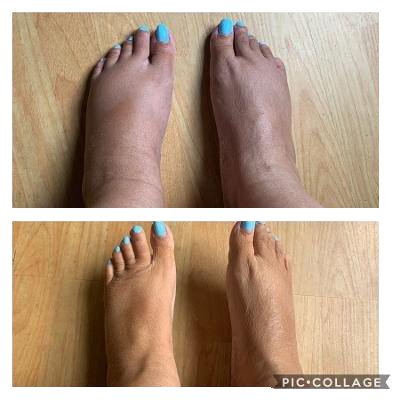Maximize Your Recovery: How Manual Lymphatic Drainage Can Benefit Post-Surgery Patients
Undergoing surgery can be incredibly stressful, both physically and emotionally. With the recovery process being equally as challenging. However, there are safe ways to speed up the recovery process. One such method is Manual Lymphatic Drainage(MLD), and in this blog post, we will explore the benefits of MLD for post-surgery patients.
Table of contents
Understanding Manual Lymphatic Drainage | Manual Lymphatic Drainage | The Lymphatic System
How surgery affects your body | How does surgery affect your lymphatic system? | Planning your recovery
Why Is MLD Massage important after cosmetic surgery? | Benefits of MLD for post-surgery patients
How to incorporate MLD into your recovery plan | How soon after surgery should I Start my MLD sessions? | How many MLD sessions will I need?
Understanding Manual Lymphatic Drainage
Before discussing the benefits of MLD, let's first discuss what it is.
Manual Lymphatic Drainage
Manual Lymphatic Drainage is a massage that uses light, rhythmic strokes to stimulate the lymphatic system.
Lymphatic System
The Lymphatic System is a network of vessels and nodes that help remove excess fluid, waste, and toxins from the body.
MLD helps to move the fluid that’s built up and allows it to move back into the lymphatic passages where excess waste and fluid can be flushed from the body. To learn more about MLD view our previous blog post - Healing at its Finest: A Beginner's Guide to Manual Lymphatic Drainage
How surgery affects your body
Surgery will cause a shock to your body. It's important to know that your body will respond with some side effects.
Pain in the area of the surgery
Fatigue
Loss of appetite
Swelling
Numbness
Bruising
Sometimes bleeding
Water retention
Remember, this is normal and is part of the healing process. But to speed up the healing process and receive better outcomes, you should start your MLD sessions as soon as possible.
How does surgery affect your lymphatic system?
After surgery, the lymphatic system can become sluggish, leading to swelling and discomfort. When the lymphatic system can no longer carry out its duties, it essentially experiences Lymphatic Congestion.
To help you better read your body and the signs of Lymphatic Congestion, we put together a list of 21 symptoms that you can observe in yourself.
-
1.Headache
2.Brain Fog
3.Swollen Lymph Nodes/Tonsils
4.Lack of Energy
5.Recurring Sore Throat
6.Mucous in the Morning
7.Mucous Drainage after Dairy and Flour
8.Fluid backup in Ears (mainly found in children)
9.Popping & Ringing Ears
10.The decrease in the ability to fight infection (recurring cold and flu)
11.Constipation and Sluggish Bowel Movements
12.Unable to lose weight (this is a significant factor for weight retention)
13.Sore or Stiff Body in the Morning
14.Bloating and Heaviness
15.Swelling in the Extremities
16.Arms and Hands fall asleep during the night
17.Pain and Pressure along the Spine and Shoulders
18.Sore breasts with Menstrual Cycles
19.Itchy Skin
20.Acne & Dry Skin
21.Other Skin-related Issues
Paying attention to how your body responds is important to promote optimal health, seek appropriate treatments and encourage healing.
Planning your recovery
Once you commit to plastic surgery, you need to plan for your recovery in advance. You should start your MLD sessions as soon as possible to speed the recovery time, improve outcomes and avoid further surgery due to complications. Some patients can begin manual lymphatic drainage within one to three days of their surgical procedure. We would recommend scheduling 8-12 follow-up sessions. However, healing after surgery varies by the individual. Considering that, proper education and self-management after surgery will also play a role in your healing process requirements.
Why is manual lymphatic drainage important after surgery?
Following surgery, it is essential to help the body drain any excess fluid that may have built up to reduce the risk of infection. MLD will do this and flush out excess anesthesia and other by-products from the surgery. Failing to do so can slow the healing process and potentially lead to complications. According to a study done by the National Library of Medicine, 26 post-surgery patients between the ages of 16-57 who received MLD treatments, observed a significant reduction in swelling and pain within the first month.
Benefits of MLD for Post-Surgery Patients
-
MLD helps to reduce swelling and inflammation by stimulating lymphatic flow, promoting the removal of excess fluid from the body. This leads to faster healing times and a reduction in discomfort.
-
MLD can help to relieve pain and discomfort by improving lymphatic flow and reducing pressure on sensitive tissues. It also stimulates the release of endorphins, the body's natural painkillers.
-
Surgery can weaken the immune system, making patients more susceptible to infections and illnesses. MLD supports the immune system by removing harmful toxins and waste products from the body, resulting in better overall health.
-
MLD helps to improve the appearance of scars by promoting healthy tissue regeneration and delivering oxygen and nutrients to the affected area.
-
MLD has a calming effect on the body, reducing stress and anxiety, and promoting better sleep and overall well-being.
How to incorporate MLD into your Recovery Plan
If you are a post-surgery patient interested in incorporating MLD into your recovery plan, it is essential to find a skilled and experienced therapist.
Look no further! Click here to book your session with our skilled therapists.
We will be able to tailor the treatment to your individual needs and ensure that it is safe and effective. MLD can be done as often as needed, depending on the severity of your symptoms and the type of surgery you underwent.
How soon after surgery should I start my MLD sessions?
Surgeons often recommend that their patients supplement their recovery with lymphatic drainage as early as possible, ideally within the first few days post-surgery. The idea behind this recommendation is that lymphatic drainage can help prevent and alleviate the build-up of fluid and the formation of scar tissue. We recommend you get your drainage tubes taken out before you come to us for your sessions.
How many sessions will I need?
The answer to that depends on the type of plastic surgery you got and how extensive it was. Most physicians will recommend a series of 2-3 sessions per week for the first 1-4 weeks. For liposuction surgeries, where the damage to the lymphatic system is more comprehensive, it may be necessary to follow a regimen for several weeks to a few months post-surgery to fully re-establish healthy lymphatic flow
Summary
Overall, MLD can be a valuable tool for post-surgery patients who are looking to maximize their recovery. It can help to reduce swelling, improve circulation, and promote healing, all of which can lead to a faster and more comfortable recovery. If you are considering MLD as part of your post-surgery recovery plan, be sure to speak with your healthcare provider to determine if it is right for you.
Say goodbye to inflammation, boost your energy levels, and feel lighter and rejuvenated with MLD. Join our community and take the first step towards a healthier, happier you. Book your first session now and feel the difference for yourself.








